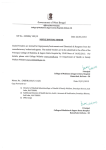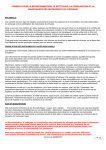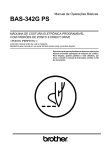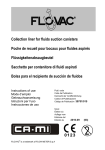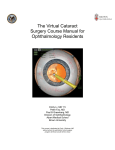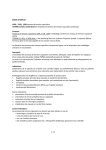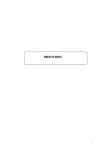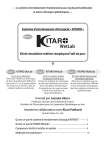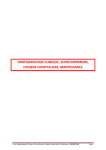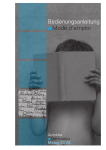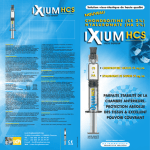Download Untitled - CROMA
Transcript
Catalogue instruments réutilisables pour la chirurgie ophtalmique Re-usable instruments for ophtalmic surgery catalogue Wiederverwendbare Instrumente für die ophthalmische Chirurgie SOMMAIRE TA B L E O F C O N T E N T S I N H A LT S V E R Z E I C H N I S Consignes de stérilisation Reprocessing instructions Wiederaufbereitungsanweisung 6 Blépharostats Eye specula Lidsperrer 18 Pinces Forceps Pinzetten 22 Ciseaux Scissors Scheren 32 Crochets Hooks Haken 40 Porte-aiguilles Needle holders Nadelhalter 44 Canules Cannulae Kanülen 48 Voies Lacrymales Lachrymal instruments Lakrimalinstrumente 54 Instruments divers Other instruments Andere Instrumente 58 Injecteurs et pinces LIO IOL injectors and forceps IOL-Injektoren und Pinzetten 62 Boîtes de stérilisation Sterilization cases Sterilisierbehälter 68 Consignes de stérilisation CONSIGNES DE STÉRILISATION I. INTRODUCTION Ces consignes de stérilisation ont pour objet de rappeler les bonnes pratiques de manipulation, décontamination, nettoyage, désinfection, stérilisation et stockage des instruments chirurgicaux. Nous tenons à vous préciser que la durée de vie et le bon fonctionnement d’un instrument de chirurgie dépend du soin apporté lors de ces étapes. Un instrument qui ne fonctionne pas correctement représente un risque potentiel pour l’utilisateur et le patient. Ces consignes ne sont qu’informatives. Il convient de vous conformer à la réglementation de votre pays et aux procédures particulières en vigueur dans votre établissement. Nos instruments sont fabriqués en acier inoxydable ou en titane de qualité chirurgicale répondant à des normes strictes établies par les autorités gouvernementales européennes et internationales. Cependant, ces instruments, lorsqu’ils sont exposés à des conditions défavorables, peuvent se corroder. Aussi, il est important de respecter un certain nombre de règles lors de leur cycle d’utilisation. II. CONDITIONS DE STOCKAGE Les instruments doivent être stockés : • dans des pièces sèches, propres et adaptées, sans écart de température, • à l’écart de substances pouvant avoir une action corrosive ou d’instruments dont la surface est corrodée ou abîmée, de préférence en fonction de la nature du matériau et en évitant leur empilage. Une attention particulière devra être apportée à leur poids (mettre les instruments les plus lourds en dessous des autres). III. SOINS ET MANUTENTION DES INSTRUMENTS • Les instruments chirurgicaux sont prévus pour un usage spécifique (couper, tenir …). Tout autre emploi que celui prévu entraînera une détérioration de l’instrument. • Avant chaque utilisation, assurez-vous de la propreté de l’instrument et vérifiez son état sous microscope. • Les instruments doivent être essuyés après chaque utilisation de façon à éliminer au préalable tout produit antiseptique, toute trace de tissus, de sang, de débris cellulaires ou d’un dépôt quelconque. De même, il est impératif d’éliminer toute substance pouvant faire obstacle à la pénétration du liquide de décontamination dans les instruments creux. • Pour le ré-acheminement de l’instrumentation souillée, veuillez utiliser des bacs ou containers adaptés. Il est recommandé d’effectuer le ré-acheminement en milieu liquide. • Le trempage prolongé des instruments dans du sérum physiologique est prohibé. Nous recommandons d’utiliser de l’eau déminéralisée. IV. INSTRUCTIONS DE NETTOYAGE Il est important de mettre en place, en accord avec le pharmacien, le médecin hygiéniste et l’ingénieur biomédical, des procédures validées de décontamination et/ou d’inactivation ainsi que de nettoyage des instruments chirurgicaux en termes d’efficacité du nettoyage, de maintien des propriétés de l’instrumentation et de conformité aux exigences nationales ou internationales (en France, circulaire DGS/5C/DHOS/E2/2001/138 en date du 14 mars 2001). Ces procédures doivent être mises en œuvre immédiatement après l’utilisation de l’instrument pour éviter que des substances organiques ne sèchent à sa surface ou dans les interstices. Selon la classification de l’Organisation Mondiale de la Santé (OMS), l’acte chirurgical en ophtalmologie est réalisé sur un organe ayant un haut potentiel d’infectiosité du fait de la contamination potentielle par les ATNC (agents de transmission non conventionnels). Les instruments doivent donc être traités à part. D’une façon générale, il convient d’inclure dans le cadre d’une procédure ophtalmologique les mentions suivantes : Trempage et Décontamination Pour éviter le séchage des souillures et le développement microbiologique sur le matériel, celui-ci doit être mis à tremper aussitôt après chaque utilisation dans un bain de trempage sans aldéhyde. Ce bain de décontamination protège le personnel manipulant les instruments ainsi que leur environnement et facilite le nettoyage ultérieur. Consignes de stérilisation Il convient alors de respecter les instructions suivantes: • Conformez-vous au mode d’emploi des solutions de décontamination, • Respectez une durée de trempage minimum de 15 minutes, • Utilisez une solution de décontamination sans chlorures, • Immergez totalement l’instrumentation dans le bain de décontamination, les instruments articulés devant être ouverts au maximum et ceux composés de plusieurs parties devant être désassemblés, • Les bacs des blocs opératoires, exclusivement réservés à la décontamination, doivent être changés après chaque intervention, • Rincez à l’eau déminéralisée. Nettoyage Le nettoyage peut-être réalisé soit en machine à laver, soit par passage aux ultrasons, soit de façon manuelle si les instruments sont toujours souillés après la phase de décontamination. Quelque soit la méthode utilisée, il est impératif de respecter le mode d’emploi des produits de nettoyage, certains pouvant permettre, dans un même temps, la décontamination et le nettoyage. Nettoyage manuel • Le nettoyage manuel nécessite l’emploi d’une brosse en plastique souple pour les manches et d’un linge propre pour les extrémités. Les brosses métalliques sont à proscrire. • Effectuez un rinçage minutieux à l’eau déminéralisée. Nettoyage en machine • Respectez les indications données par le fabricant de la machine. • En positionnant les instruments, veillez à ce qu’ils ne s’entrechoquent pas ou qu’ils ne se détériorent pas. • Tenez compte du poids et de la forme des instruments. Les instruments lourds doivent être placés sous les plus légers alors que les instruments creux sont placés dans les paniers. Les zones d’ombre doivent être évitées, les instruments articulés doivent être ouverts au maximum et ceux composés de plusieurs parties doivent être désassemblés. • Ne surchargez pas les paniers et la machine. Nettoyage aux ultrasons Le nettoyage aux ultrasons n’est pas recommandé. Cependant, si cette méthode de nettoyage est employée, il convient de respecter les règles de base suivantes : • Conformez-vous aux indications données par le fabricant de la machine. • Respectez une température de 40-45°C. • Utilisez une fréquence comprise entre 25 et 50 kHz. • Le cycle de nettoyage ne doit pas excéder 5 minutes (temps de dégazage exclu). • Utilisez un produit nettoyant et/ou mouillant approprié. • Il est recommandé de traiter à part les instruments fragiles, en évitant tout frottement sur les parties les plus altérables. Inactivation des ATNC Les agents responsables de la maladie de Creutzfeldt Jakob, agents transmissibles non conventionnels (ATNC) ou « prions », sont particulièrement résistants à de nombreux traitements physiques et chimiques. Les traitements habituels sont peu ou pas efficaces (chaleur jusque 130°C/226°F en milieu humide, ultrasons, UV, éthanol, formaldéhyde...). Il convient d’inclure dans la procédure de prétraitement une inactivation particulière. Pour la France, se reporter aux recommandations du Ministère de la Santé relative “aux précautions à observer en milieu chirurgical (...) face aux risques de transmission de la maladie de Creutzfeldt Jakob”. • Préférer l’inactivation physique (entre 134°C et 138°C pendant 18 minutes, autoclave à charge poreuse). • Proscrire l’utilisation de l’hypochlorite de sodium (eau de Javel). • En cas d’inactivation chimique, procéder à un rinçage à l’eau déminéralisée. NB : pour les instruments en titane, le traitement à l’hydroxyde de sodium peut entraîner une décoloration du bleu anodisé. Cependant, cela n’a pas d’incidence sur l’état de la surface de l’instrument. La mise en œuvre d’une inactivation chimique ne dispense pas d’une étape de stérilisation. Consignes de stérilisation Rinçage / Séchage Tous les instruments doivent être rincés à l’eau déminéralisée et séchés rapidement et soigneusement à l’aide d’un linge propre ou d’air comprimé filtré. V. CONTROLE / ENTRETIEN / REPARATIONS Afin d’éviter la corrosion ou l’apparition de taches, des contrôles réguliers seront effectués et des actions correctives devront être prises durant toute la vie de l’instrument. Ces contrôles porteront sur la propreté, le fonctionnement et l’aspect des instruments. Suite à ces contrôles, il peut apparaître que certains instruments aient besoin d’être lubrifiés, affûtés ou réparés. La lubrification peut se faire en interne. Il faut cependant faire attention à la qualité du lubrifiant, celui-ci devant, par exemple, être perméable à l’eau pour permettre une stérilisation à l’autoclave (dans ce cas, proscrire le silicone). CROMA GmbH assure la réparation des instruments vendus par ses services. Les instruments doivent nous être retournés, après avoir subi la procédure complète de traitement décrite ci-dessus, dans un conditionnement similaire à celui dans lequel ils vous ont été livrés de façon à garantir des conditions adéquates de retour. Un devis vous sera envoyé sur demande. Si votre instrument est irréparable, nous vous contacterons afin de définir ensemble des suites à donner. VI. STERILISATION Après recomposition des paniers (instruments au premier rang de la crémaillère et en faisant attention à ne pas les surcharger), trois modes de stérilisation peuvent être mis en œuvre : • Stérilisation à la vapeur (autoclave à charge poreuse) 134°C pendant 18 minutes (temps théorique dans des conditions idéales). • Stérilisation à la vapeur (autoclave) 121°C pendant 20 minutes. • Stérilisation à l’oxyde d’éthylène. Dans le cas de la stérilisation à la vapeur, les instruments doivent être exempts de traces d’huile et d’autres impuretés et ne doivent contenir aucun autre produit chimique de correction. La stérilisation d’un instrument en position fermée est interdite. Les durées et conditions de stérilisation recommandées peuvent varier d’un pays à un autre. Il convient de vous conformer à la réglementation de votre pays et aux procédures particulières en vigueur dans votre établissement. VII. RECOMMANDATIONS • Les instruments CROMA, livrés non stériles doivent impérativement suivre un protocole de décontamination, nettoyage, désinfection et/ou stérilisation avant toute utilisation. Après vérification des instruments (absence de trace), ce premier cycle de traitement servira à valider la procédure pour l’ensemble des instruments. • L’utilisation d’eau déminéralisée lors des rinçages diminue les risques de taches, ternissures, et de piqûres de corrosion. VIII. ECHANGE / GARANTIE • Ne seront échangés que les instruments neufs n’ayant jamais été utilisés et/ou stérilisés ou ceux présentant un défaut lors de leur première utilisation. • Tous nos instruments bénéficient d’une garantie d’un an à partir de la date de facturation dans le cadre d’une utilisation appropriée et d’un entretien correspondant à ceux décrits ci-dessus et en l’absence de chutes ou de chocs. Dernière révision : 05/2009 Reprocessing instructions REPROCESSING INSTRUCTIONS I. INTRODUCTION The purpose of these reprocessing instructions is to stress the importance of proper handling, decontamination, cleaning, disinfection, sterilization and storage practices of surgical instruments. We would like to point out that the service life and functionality of a surgical instrument depend on the care given to all these steps. An instrument that does not work properly is a potential risk for user and patient. These instructions are for your information only. You have to comply with the statutory regulations in your country as well as the specific procedures that are in use in your hospital/clinic. Our surgical quality stainless steel or titanium instruments meet very strict standards that have been defined by the European and international statutory authorities. However, when exposed to inappropriate storage conditions, these instruments may corrode. Therefore, a certain number of rules should be followed during their using cycle. II. STORAGE CONDITIONS The instruments should be stored: • in appropriate, dry and clean rooms, without any temperature deviation, • away from substances that may be corrosive and away from instruments with a corroded or damaged surface, preferably according to the items’ type of material and without piling them up. Attention should be paid to their weight (put the heaviest instruments underneath the others). III. CARE AND HANDLING • Surgical instruments have a specific intended use (cutting, holding …). Any improper use of the instrument will cause its deterioration. • Before each use, make sure the instrument is clean and check its state under a microscope. • All instruments must be wiped after each use, so as to eliminate any mark of antiseptic solution, any traces of tissues, cellular deposits, blood traces or any other deposits. Any substance that might prevent the decontamination liquid from entering hollow instruments must be removed as well. • To return soiled instruments, please use appropriate trays or containers. The instruments should be returned in a liquid. • Prolonged soaking in a physiological saline solution is prohibited. We recommend using distilled water. IV. CLEANING INSTRUCTIONS Validated decontamination and/or inactivation as well as cleaning procedures must be set up in collaboration with the pharmacist, the hygienist and the biomedical engineer of the various hospitals/clinics, in terms of efficacy, maintenance of the surgical instruments properties and compliance with national and international requirements (for France, please refer to circular letter DGS/5C/DH0S/E2/2001/138 dated 14 March 2001). The above-mentioned procedures must be implemented immediately after using the instrument to avoid drying of any organic substance on the surface of the instrument or in its hollow parts. According to the World Health Organization (WHO) classification, ophthalmic surgical procedure is performed on an organ with high infection risks due to the NCTA (non conventional transmissible agents). The instruments must therefore be handled separately. The above-mentioned procedures should include the following conditions: Immersion and decontamination In order to prevent stains or impurities from drying and microbiological contamination on the instrument, it must be immersed immediately after use in an aldehyde-free decontaminating bath. This decontaminating immersion protects the staff in charge of instrument handling as well the environment and facilitates further cleaning procedures. Reprocessing instructions 10 The following should then be taken into account: • Comply with the instructions for use of the decontaminating solutions • Minimum soaking time of 15 minutes • Use a chloride-free solution • The instruments must be immersed completely in a decontaminating bath, hinged-joint instruments must be completely opened and those made of several parts must be disassembled. • The sieving trays in operating rooms that are exclusively dedicated to decontamination must be changed after each surgery. • Rinse with distilled water. Cleaning Cleaning can be performed either in a machine or by ultrasound or manually if impurities are still visible on the instruments after decontamination. Regardless of the cleaning method that is used, the detergents’ instructions for use have to be followed as some of them can be used for decontamination and cleaning at the same time. Manual cleaning • Manual cleaning requires the use of a soft plastic brush for cleaning the handles and a soft clean cloth for the tips. Metal brushes are forbidden. • Thoroughly rinse with distilled water Mechanical cleaning • The manufacturer’s instructions are to be followed • When positioning the instruments ensure that they do not come into contact with one another and that they are not damaged. Consider the weight and the shape of the instruments. Heavy instruments should be placed beneath lighter ones whereas hollow instruments must be put into a disinfection basket. Shadow areas must be avoided and hinged instruments must be completely opened and those made up of several parts must be disassembled. • Do not put too many instruments in the disinfection baskets and in the machine. Ultrasound cleaning Ultrasound cleaning is not recommended. However, if this cleaning method is applied, the following basic measures must be taken into account: • The instructions given by the manufacturer must be followed. • Temperature must be of 40-45°C. • A frequency ranging from 25 to 50 KHz should be used. • The ultrasound cleaning cycle should not exceed 5 minutes (excluding degassing time). • Use a suitable cleaning and/or moisturising agent. • Fragile instruments should be treated separately and the metal parts of the most delicate instruments should not be rubbed against metal. NCTA inactivation The agents that are responsible for Creutzfeldt-Jakob disease, non conventional transmissible agents (NCTA) also known as “prions”, are particularly resistant to numerous physical and chemical treatments. Since the current treatments are not or only partially efficient (130°C/226°F temperature in humid environment, ultrasounds, UV, ethanol, formaldehyde …), a particular inactivation procedure should be included in the pre-treatment procedure. For France, please refer to the recommendations provided by the French Ministry of Health concerning “the measures to be followed in the surgical field (…) with respect to the transmission risks of the Creutzfeldt-Jakob disease”. • Preferably use physical inactivation (between 134°C and 138°C for 18 minutes, autoclave sterilization for porous instruments) • The use of sodium hypochlorite (bleach) is forbidden. • In case of chemical inactivation, rinse with distilled water. NB: for titanium instruments, treatment with sodium hydroxide may cause anodised blue to fade. However it will not affect the state of the instrument’s surface. Despite chemical inactivation sterilization is always necessary. 11 Reprocessing instructions Rinsing / Drying All instruments must be rinsed with distilled water and dried rapidly and carefully with a clean cloth or with filtered compressed air. V. CONTROL/ CLEANING/ REPAIRS In order to prevent corrosion marks or stains from appearing, the instruments should be checked regularly and corrective measures should be taken during the instrument’s life span. Check if the instruments are clean, in good condition and working properly. Following control, some of the instruments may need lubrication, re-sharpening or repairing. Lubrication can be performed in-house. Yet, mind the quality of the lubricating solution which has to be water-permeable to permit autoclaving (in this case do not use silicone oil). CROMA GmbH deals with the repairs of the instruments which it sells. The instruments must be returned to the supplier after being cleaned according to all the above-mentioned instructions and in the same type of packaging as the one in which they were delivered in order to guarantee appropriate return conditions. Estimates are available on request. If your instrument cannot be repaired, we will contact you to discuss further steps. VI. STERILIZATION After placing the instruments in disinfection baskets (place the instruments in the first rank and make sure not to put too many), three sterilization methods may be used: • Steam sterilization (porous load autoclave): 134 °C, for 18 minutes (theoretical time for ideal conditions) • Steam sterilization (autoclave): 121 °C for 20 minutes. • Ethylene oxide sterilization. In case of steam sterilization, the instruments should not show any trace of oil or of any other impurity or contain any other correcting chemical solution. Sterilization of an instrument in a closed position is forbidden. The sterilization time and conditions recommended may vary from country to country. Please refer to the regulations in your country and the specific procedures required by your hospital/clinic. VII. RECOMMENDATIONS • CROMA instruments that are delivered non-sterile must be decontaminated, cleaned, disinfected and/or sterilized before use. Once the instruments have been checked (no impurities visible), the first reprocessing cycle is used as a validation basis of the reprocessing procedure of all instruments. • Rinsing the instruments with distilled water reduces the risks of stains, tarnishing and corrosion marks. VIII. EXCHANGE/ GUARANTEE • Only new instruments that have never been used and/or sterilized or those showing a defect when being used for the first time will be exchanged. • All of our instruments have a one-year guarantee starting from the invoice date, provided that they are used and cleaned in accordance with the above-mentioned instructions and have not been dropped or subject to any other shock impact. Latest revision: 05/2009 Wiederaufbereitungsanweisung 12 WIEDERAUFBEREITUNGSANWEISUNG I. EINFÜHRUNG Sinn und Zweck der Wiederaufbereitungsanweisung ist es, die Wichtigkeit angemessener Handhabung, Dekontamination, Reinigung, Desinfektion, Sterilisierung und Lagerungspraktiken chirurgischer Instrumente zu betonen. Wir möchten darauf hinweisen, dass die Betriebsdauer und Funktionalität eines chirurgischen Instruments von der sorgfältigen Befolgung der genannten Schritte abhängt. Ein nicht einwandfrei funktionierendes Instrument stellt einen potentiellen Risikofaktor für den Patienten dar. Diese Anweisungen sind rein informativ. Sie müssen dem in Ihrem Land gesetzlich vorgeschriebenen Reglement als auch dem üblichen Prozedere Ihres Krankenhauses/Ihrer Klinik Folge leisten. Unsere chirurgischen Qualitätsinstrumente aus Edelstahl oder Titan erfüllen strenge Normen, welche von europäischen und internationalen gesetzlich befugten Autoritäten definiert wurden. Bei unangemessener Lagerung ist eine Korrosion nicht auszuschließen. Während eines Gebrauchszyklus sollten daher bestimmte Regeln befolgt werden. II. LAGERBEDINGUNGEN Die Instrumente sollten folgendermaßen gelagert werden: • unter angemessenen, trockenen und sauberen Bedingungen ohne Temperaturabweichungen. • fern von korrosiven Substanzen oder Instrumenten mit verrosteten oder beschädigten Oberflächen, am besten entsprechend des Produktmaterials ohne sie zu stapeln. Beachten Sie das Gewicht der Instrumente (lagern sie die schwereren unter den leichteren). III. WARTUNG UND HANDHABUNG • Chirurgische Instrumente haben einen bestimmten Verwendungszweck (schneiden, halten …). Jegliche unzulässige Handhabung des Instruments begünstigt Verschleiß. • Stellen Sie vor jeder Verwendung sicher, dass das Instrument sauber ist und prüfen Sie seinen Zustand unter einem Mikroskop. • Die Instrumente müssen nach jeder Verwendung gereinigt werden, um jegliche Spuren von antiseptischer Lösung, Gewebe, zellulären Ablagerungen, Blut oder anderen Ablagerungen zu eliminieren. Jegliche Substanz die ein Eindringen der Dekontaminierungsflüssigkeit in hohle Instrumente verhindert, muss ebenfalls beseitigt werden. • Deponieren Sie die gebrauchten Instrumente in geeigneten Behältern für die nachfolgende Reinigung. Die Instrumente sollten in entsprechender Flüssigkeit zur Reinigung geschickt werden. • Verlängertes Einweichen in einer physiologischen Kochsalzlösung sollte vermieden werden. Empfohlen wird destilliertes Wasser. IV. REINIGUNGSANWEISUNGEN Gültige Dekontamination und/ oder Inaktivierung als auch Reinigungsabläufe müssen in Zusammenarbeit mit einem Pharmazeuten, Hygieniker und biomedizinischem Ingenieur der einzelnen Kliniken/ Krankenhäuser bezüglich Effizienz, Instandhaltung und Erfüllung nationaler und internationaler Anforderungen (für Frankreich beziehen Sie sich bitte auf das Rundschreiben DGS/5C/DH0S/E2/2001/138 vom 14. März 2001) aufgesetzt werden. Die oben genannten Vorgangsweisen müssen sofort nach Gebrauch der Instrumente angewandt werden, um ein Antrocknen jeglicher organischer Ablagerungen an der Instrumentenoberfläche oder in Aushöhlungen zu vermeiden. Entsprechend der Klassifizierung der Weltgesundheitsorganisation (WHO) erfolgen ophthalmisch-chirurgische Eingriffe an einem Organ mit hohem Infektionsrisiko aufgrund von NCTA (non conventional transmissible agents) (unkonventionell 13 Wiederaufbereitungsanweisung übertragbare Krankheitserreger) Die Instrumente müssen daher separat gehandhabt werden. Die oben genannten Abläufe sollten folgende Vorgaben beinhalten: Immersion und Dekontamination Um das Eintrocknen von Flecken oder Unreinheiten sowie mikrobiologische Kontamination am Instrument zu vermeiden, muss es sofort in ein aldehydfreies Dekontaminierungsbad getaucht werden. Diese Dekontamination schützt das handhabende Personal als auch die Umwelt und erleichtert weitere Reinigungsabläufe. Folgende Punkte sollten außerdem in Betracht gezogen werden: • Befolgen Sie die Benutzungsanweisungen für die Dekontaminationslösung • Weichen Sie die Instrumente mindestens 15 Minuten ein • Verwenden Sie chloridfreie Lösung • Instrumente müssen gänzlich in die Lösung getaucht, Scharniergelenk-Instrumente vollständig geöffnet, zusammengesetzte Instrumente zerlegt werden. • Speziell für die Dekontamination vorgesehene Siebschalen in Operationssälen müssen nach jedem chirurgischen Eingriff ausgetauscht werden. • Spülen Sie mit destilliertem Wasser. Reinigung Die Reinigung kann entweder in einer Maschine, mit Ultraschall oder händisch erfolgen, falls noch sichtbare Unreinheiten nach der Dekontamination bestehen. Ungeachtet der angewendeten Reinigungsmethoden müssen die Nutzungsanweisungen für das Reinigunsmittel befolgt werden, da einige sowohl für die Reinigung als auch für die Dekontamination verwendet werden können. Manuelle Reinigung • Die manuelle Reinigung der Griffe erfolgt mit einer Plastikbürste, die Reinigung der Spitze mit einem weichen, sauberen Stoff. Metallbürsten dürfen nicht eingesetzt werden. • Spülen Sie gründlich mit destilliertem Wasser. Mechanische Reinigung • Die Anweisungen des Herstellers sind zu befolgen • Bei der Positionierung der Instrumente stellen Sie sicher, dass sie sich gegenseitig nicht berühren und dass sie nicht schadhaft sind. Berücksichtigen Sie das Gewicht und die Form der Instrumente. Schwere Instrumente sollten unter leichteren positioniert werden, Hohlinstrumente müssen in einen Desinfektionskorb platziert werden. Instrumente müssen so positioniert werden, dass die maschinelle Reinigung an allen Stellen erfolgen kann; Scharniergelenkinstrumente müssen gänzlich geöffnet, zusammengesetzte Instrumente zerlegt werden. • Überladen Sie weder Maschine noch Desinfektionskorb Ultraschallreinigung Ultraschallreinigung wird nicht empfohlen. Wird diese Reinigungsmethode trotzdem angewandt, müssen folgende grundlegende Maßnahmen beachtet werden: • Die Anweisungen des Herstellers müssen befolgt werden. • Die Temperatur muss bei 45 °C gehalten werden. • Die Reinigung sollte in einem Frequenzbereich zwischen 25 und 50 KHz erfolgen. • Der Ultraschall-Reinigungszirkel sollte nicht länger als 5 Minuten dauern (mit Ausnahme der Entgasungszeit). • Verwenden Sie ein entsprechendes Reinigungsmittel • Empfindliche Instrumente sollten gesondert behandelt werden. Metallteile besonders empfindlicher Instrumente sollten anderes Metall nicht berühren. Wiederaufbereitungsanweisung 14 NCTA Inaktivierung Überträger der Creutzfeldt-Jakob-Krankheit, unkonventionell übertragbare Krankheitserreger (NCTA), auch bekannt als „Prionen“, sind besonders resistent gegen zahlreiche physikalische und chemische Behandlungen. Da die derzeitigen Behandlungen nicht oder nur teilweise effektiv sind (130 °C/ 226 °F Temperatur in feuchter Umgebung, Ultraschall, UV, Äthanol, Formaldehyde …), sollte ein besonderer Inaktivierungsprozess in die Vorbehandlung inkludiert werden. Für Frankreich beachten Sie bitte die Empfehlungen des französischen Gesundheitsministeriums bezüglich der „zu befolgenden Maßnahmen in der Chirurgie […] hinsichtlich der Übertragungsrisiken der Creutzfeldt-Jakob-Krankheit“. • Eine physikalische Inaktivierung ist zu bevorzugen (zwischen 134 °C und 138 °C für 18 Minuten, AutoklavSterilisation bei porösen Instrumenten). • Die Verwendung von Natriumhypochlorit ist unbedingt zu vermeiden. • Bei chemischer Inaktivierung mit destilliertem Wasser spülen. Bei Instrumenten aus Titan kann eine Behandlung mit Natriumhydroxit das Schwinden der Eloxal-Schicht verursachen. Es erfolgt allerdings keine Beeinträchtigung der Instrumentenoberfläche. Trotz der chemischen Inaktivierung ist eine Sterilisation immer notwendig. Spülen/ Trocknen Alle Instrumente müssen mit destilliertem Wasser gespült sowie rasch und vorsichtig mit einem sauberen Tuch oder gefilterter Druckluft getrocknet werden. V. KONTROLLE/ REINIGUNG/ REPARATUREN Um jegliche Korrosionsflecken zu vermeiden, müssen die Instrumente regelmäßig kontrolliert und, falls notwendig, Korrektivmaßnahmen ergriffen werden. Kontrollieren Sie, ob die Instrumente sauber und in gutem Zustand sind sowie richtig funktionieren. Überprüfen Sie im Anschluss, ob die Instrumente geölt, geschärft oder repariert werden müssen. Ein Ölen der Instrumente kann intern erfolgen. Beachten Sie jedoch die Qualität der Ölung: sie muss wasserdurchlässig sein um ein Autoklavieren zu ermöglichen (in diesem Fall sollten Sie kein Silikonöl verwenden). Sämtliche Reparaturen der von CROMA GmbH hergestellten Instrumente werden von CROMA GmbH durchgeführt. Für Reparaturen müssen die Instrumente wie oben beschrieben gereinigt und in der gleichen Verpackung, in der sie geliefert wurden, an den Hersteller zurückgesendet werden, um eine adäquate Retournierung zu gewährleisten. Kostenvoranschläge erfolgen nach Anfrage. Sollte eine Reparatur Ihres Instruments nicht möglich sein, werden wir bezüglich der weiteren Vorgehensweisen mit Ihnen in Kontakt treten. VI. STERILISATION Nach Positionierung der Instrumente im Desinfektionskorb (platzieren Sie die Instrumente in der ersten Reihe aber überfüllen Sie diese nicht) können drei verschiedene Sterilisationsmethoden angewendet werden: • Dampf-Sterilisation (Autoklav-Sterilisation für poröse Instrumente): 134 °C, für 18 Minuten (theoretische Zeit für den Idealzustand) • Dampf-Sterilisation (Autoklav-Sterilisation), 121 °C für 20 Minuten • Äthylenoxid-Sterilisation Im Fall einer Dampf-Sterilisation sollten die Instrumente keinerlei Spuren an Öl oder anderen Verunreinigungen sowie chemischen Lösungen aufweisen. Scharniergelenk-Instrumente dürfen niemals im geschlossenen Zustand sterilisiert werden. Empfohlene Sterilisationszeit und -bedingungen können von Land zu Land variieren. Bitte beachten Sie die Bestimmungen Ihres Landes und die vorgeschriebenen spezifischen Abläufe Ihrer Klinik. VII. EMPFEHLUNGEN • Instrumente von CROMA, die nicht steril geliefert wurden, müssen vor Erstbenutzung dekontaminiert, gereinigt, desinfiziert und/ oder sterilisiert werden. 15 Wiederaufbereitungsanweisung Sobald die Instrumente überprüft wurden (keine sichtbaren Verunreinigungen), sollte der erste WiederaufbereitungsZyklus als Basis für alle weiteren Wiederaufbereitungsprozesse gelten. • Das Spülen der Instrumente mit destilliertem Wasser reduziert das Risiko der Entstehung von Flecken, Trübung und Rostmalen. VIII. AUSTAUSCH/ GARANTIE • Nur neue, unbenutze und noch nicht sterilisierte sowie bei der Erstanwendung defekte Instrumente werden ausgetauscht. • Alle unsere Instrumente verfügen über ein Jahr Garantie, beginnend mit dem Rechnungsdatum, vorausgesetzt, dass eine wie oben beschriebene Reinigung und Nutzung erfolgt ist, die Instrumente nicht fallen gelassen oder anderen Stoß- und Schlageinwirkungen ausgesetzt wurden. Blépharostats Eye specula Lidsperrer Blépharostats Eye specula Lidsperrer 18 E-10000* Blépharostat de BARRAQUER, enfant, fenêtres de 10 mm BARRAQUER wire speculum, small, child size, 10 mm blades BARRAQUER Lidsperrer, klein, 10 mm E-10001* Blépharostat de BARRAQUER, adulte, fenêtres de 15 mm BARRAQUER wire speculum, large, adult size, 15 mm blades BARRAQUER Lidsperrer, groß, 15 mm E-10002 Blépharostat de BARRAQUER, bébé, fenêtres de 5 mm BARRAQUER speculum, paediatric size, 5 mm blades BARRAQUER Drahtlidsperrer, für Kleinkinder, 5 mm E-10005* Blépharostat de KRATZ-BARRAQUER, fenêtres ouvertes KRATZ-BARRAQUER wire speculum with open blades KRATZ-BARRAQUER Drahtlidsperrer, offen E-10006 Blépharostat temporal, fenêtres rondes et ouvertes Temporal wire speculum, open and round blades TEMPORAL Drahtlidsperrer, gefenstert 19 Blépharostats Eye specula Lidsperrer E-10011 Blépharostat de BARRAQUER, fenêtres pleines BARRAQUER wire speculum, solid blades BARRAQUER Drahtlidsperrer, geschlossen E-10061* Blépharostat de CASTROVIEJO standard, à vis, fenêtres 16 mm CASTROVIEJO standard speculum, 16 mm blades, adjustable CASTROVIEJO Lidsperrer geschlossen, mit Feststellschraube, 16 mm E-10061/S E-40100* Blépharostat de CASTROVIEJO, à vis, fenêtres ouvertes 16 mm CASTROVIEJO speculum, adjustable, 16 mm open blades CASTROVIEJO Lidsperrer offen, mit Feststellschraube, 16 mm Blépharostat de LIEBERMANN, spécial phaco, à vis, angulé, fenêtres ouvertes LIEBERMANN wire speculum, for phaco, adjustable, angled, open blades LIEBERMANN Drahtlidsperrer offen, abgewinkelt, mit Feststellschraube Pinces Forceps Pinzetten Pinces capsulorhexis Capsulorhexis forc e p s Kapsulorhexis-Pinz e t t e n Pinces standards 22 Standard forceps Standard-Pinzetten D-7311* Pince à capsulorhexis d’UTRATA, droite, ultra fine UTRATA capsulorhexis forceps, straight, very delicate UTRATA Kapsulorhexis-Pinzette, gerade, extra fein D-7315* Pince à capsulorhexis de MASKET, courbe, ultra fine MASKET capsulorhexis forceps, curved, with very delicate tip MASKET Kapsulorhexis-Pinzette, gebogen, extra fein 2760B-3150 Pince à capsulorhexis de CORYDON, courbe, en titane CORYDON capsulorhexis forceps, curved, titanium CORYDON Kapsulorhexis-Pinzette,Titan, gebogen 2760B-3127 Pince à capsulorhexis de CORYDON, droite, en titane CORYDON capsulorhexis forceps, straight, titanium CORYDON Kapsulorhexis-Pinzette, Titan, gerade 23 Pinces pour mini-micro incisions F-2055 FR-2266 Pinces capsulorhexis Capsulorhexis forceps Kapsulorhexis-Pinzetten Mini-micro incision forceps Mini-/ Mikroinzision-Pinzetten Pince à capsulorhexis d’INAMURA, en titane INAMURA capsulorhexis forceps, titanium INAMURA Kapsulorhexis-Pinzette, Titan Pince à capsulorhexis d’IKEDA 23G, à commande distale, en titane IKEDA capsulorhexis forceps 23G, squeeze handle, titanium IKEDA Kapsulorhexis-Pinzette 23 G, distaler Griff, Titan Pinces de Bonn Bonn forceps Pinzetten nach Bo n n 24 D-7280* Pince de BONN, modèle long, à plateaux, 1x2 dents de 0.12 mm BONN forceps, long model, with tying platform, 1x2 teeth 0.12 mm Irispinzette Modell BONN, lang, gerade, mit Fadenplatte, chirurgisch, 0,12 mm D-7500 Pince à suture de CASTROVIEJO, à plateaux, 1x2 dents de 0.12 mm CASTROVIEJO suturing forceps, with tying platform, 1x2 teeth 0.12 mm Nahtpinzette nach CASTROVIEJO, gerade, mit Fadenplatte, chirurgisch, 0,12 mm D-7501* Pince à suture de CASTROVIEJO, à plateaux, 1x2 dents de 0.3 mm CASTROVIEJO suturing forceps, with tying platform, 1x2 teeth 0.3 mm Nahtpinzette nach CASTROVIEJO, gerade, mit Fadenplatte, chirurgisch, 0,3 mm D-7540* Pince de BONN, modèle long, à plateaux, 1x2 dents de 0.1 mm BONN forceps, long model, with tying platform, 1x2 teeth 0.1 mm Irispinzette Modell BONN, lang, gerade, chirurgisch, 0,1 mm 25 D-7550* 2756B-2029 Pinces de Bonn Bonn forceps Bonn Pinzetten Pince de BONN, modèle court 70 mm, à plateaux, 1x2 dents de 0.12 mm BONN forceps, short model 70 mm, with tying platform, 1x2 teeth 0.12 mm Irispinzette Modell BONN, kurz, 70 mm gerade, mit Fadenplatte, chirurgisch, 0,12 mm Pince de BONN, en titane BONN forceps, titanium Irispinzette Modell BONN, gerade, chirurgisch, Titan Pinces Colibri Colibri forceps Kolibri-Pinzetten D-8110* Pince COLIBRI, à plateaux, 1x2 dents de 0.12 mm COLIBRI forceps, with tying platform, 1x2 teeth 0.12 mm KOLIBRI Pinzette, mit Fadenplatte, chirurgisch, 0,12 mm Pinces à monofilament Tying forceps Fadenpinzetten 26 D-7150* Pince à fils de JAFFE (TROUTMAN), plateaux mousses 6 mm, droite, pour monofil 10/0 JAFFE (TROUTMAN) tying forceps, smooth jaws with 6 mm long platform, straight, for 10/0 sutures Fadenpinzette nach JAFFE (TROUTMAN), gerade, 6 mm Fadenplatte, für 10/0 Nahtmaterial D-7151* Pince à fils de JAFFE (TROUTMAN), plateaux mousses 6 mm, courbe, pour monofil 10/0 JAFFE (TROUTMAN) tying forceps, smooth jaws with 6 mm long platform, curved, for 10/0 sutures Fadenpinzette nach JAFFE (TROUTMAN), gebogen, 6 mm Fadenplatte, für 10/0 Nahtmaterial D-8051* Pince à fils de TENNANT, plateaux 6 mm, très fine, pour monofil 10/0 TENNANT tying forceps, with 6 mm long platform, delicate, for 10/0 sutures Fadenpinzette nach TENNANT, 6 mm Fadenplatte, fein, für 10/0 Nahtmaterial 2756B-2097 Pince de TROUTMAN, courbe, en titane TROUTMAN forceps, curved, titanium Fadenpinzette nach TROUTMAN, gebogen, Titan 27 Pinces de Paufique Paufique forceps Nahtpinzette nach Paufique D-7790* Pince à suture de PAUFIQUE, à plateaux, 1x2 dents de 0.3 mm PAUFIQUE suture forceps, with tying platform, 1x2 teeth 0.3 mm Nahtpinzette nach PAUFIQUE, gerade, mit Fadenplatte, chirurgisch, 0,3 mm D-7791* Pince à suture de PAUFIQUE, à plateaux, 1x2 dents de 0.5 mm PAUFIQUE suture forceps, with tying platform, 1x2 teeth 0.5 mm Nahtpinzette nach PAUFIQUE, gerade, mit Fadenplatte, chirurgisch, 0,5 mm D-7792* Pince à suture de PAUFIQUE, à plateaux, 1x2 dents de 0.9 mm PAUFIQUE suture forceps, with tying platform, 1x2 teeth 0.9 mm Nahtpinzette nach PAUFIQUE, gerade, mit Fadenplatte, chirurgisch, 0,9 mm Autres pinces Other forceps Andere Pinzette n 28 D-7730* Pince à fixer le muscle droit supérieur d’ELSCHNIG, 1x2 dents obliques ELSCHNIG superior rectus fixation forceps, straight, 1x2 angled teeth Zügelnahtpinzette nach ELSCHNIG, chirurgisch D-7761 Pince à fixer de GREEN (DUJARDIN), à dents horizontales, écartement des mors 10 mm GREEN (DUJARDIN) forceps, horizontal teeth, 10 mm wide jaws Fixierpinzette nach GREEN (DUJARDIN), 10,0 mm D-8361 Pince à chalazion de DESMARRES, extrémité ovale, 26 mm DESMARRES chalazion forceps, oval, 26 mm Chalazionpinzette nach DESMARRES, oval, 26 mm D-9710* Pince moustique de HARTMANN, très fine, 9.5 cm, droite HARTMANN mosquito forceps, delicate, 9.5 cm long, straight Arterienklemme nach HARTMANN, gerade, 9,5 cm 29 Autres pinces Other forceps Andere Pinzetten D-9711* Pince moustique de HARTMANN, très fine, 9.5 cm, courbe HARTMANN mosquito forceps, delicate, 9.5 cm long, curved Arterienklemme HARTMANN, gebogen, 9,5 cm D-9723* Pince de DIEFFENBACH (WECKER), mors striés, 5 cm, courbe DIEFFENBACH (WECKER) serrefine, serrated jaws, 5 cm long, curved DIEFFENBACH-Klemme, gebogen, 5 cm D-9731 Pince de JOHN HOPKINS, mors striés, 6.5 cm, courbe JOHN HOPKINS serrefine, serrated jaws, 6.5 cm long, curved Gefäßklemme nach JOHN HOPKINS, 6,5 mm Ciseaux Scissors Scheren Ciseaux de Katzin Katzin scissors Katzin Scheren 32 A-1330* Micro ciseaux de KATZIN, courbes, lames coudées à droite KATZIN micro scissors, curved, right angled blades Federschere nach KATZIN, rechts, gebogen, stumpf A-1340* Micro ciseaux de KATZIN, courbes, lames coudées à gauche KATZIN micro scissors, curved, left angled blades Federschere nach KATZIN, links, gebogen, stumpf 33 Ciseaux standards Ciseaux de Vannas et Noyes Va n n a s a n d N o y e s s c i s s o r s Va n n a s u n d N o y e s S c h e r e n Standard scissors Standardscheren A-1780* Ciseaux de NOYES (VANNAS), droits, lames courtes, pointus, 10.5 cm NOYES (VANNAS) scissors, straight, small blades, sharp, 10.5 cm Federschere nach NOYES (VANNAS), gerade, 10,5 cm, spitz A-1790* Ciseaux de NOYES (VANNAS), courbes, lames courtes, pointus, 10.5 cm NOYES (VANNAS) scissors, curved, small blades, sharp, 10.5 cm Federschere nach NOYES (VANNAS), gebogen, 10,5 cm, spitz A-1793* Ciseaux de NOYES (VANNAS), courbes, lames courtes, mousses, 10.5 cm NOYES (VANNAS) scissors, curved, small blades, blunt, 10.5 cm Federschere nach NOYES (VANNAS), gebogen, 10,5 cm, stumpf Ciseaux de Vannas et Noyes Vannas and Noyes sc i s s o r s Vannas und Noyes S c h e r e n Micro ciseaux 34 Micro scissors A-1920* Ciseaux de VANNAS, droits, micro lames 11 mm, pointus VANNAS scissors, straight, 11 mm micro blades, sharp Federschere nach VANNAS, gerade, spitz, 11 mm A-1930* Ciseaux de VANNAS, courbes, micro lames 11 mm, pointus VANNAS scissors, curved, 11 mm micro blades, sharp Federschere nach VANNAS, gebogen, spitz, 11 mm A-1980* Ciseaux de VANNAS, droits, micro lames 12 mm, mousses VANNAS scissors, straight, 12 mm micro blades, blunt Federschere nach VANNAS, gerade, stumpf, 12 mm A-1990* Ciseaux de VANNAS, courbes, micro lames 12 mm, mousses VANNAS scissors, curved, 12 mm micro blades, blunt Federschere nach VANNAS, gebogen, stumpf, 12 mm Mikroscheren 35 Ciseaux d’ophtalmologie Ophthalmic scissors Augenscheren A-3320* Ciseaux d’ophtalmologie standards, droits, pointus Eye scissors, standard, straight, pointed tips Augenschere, gerade, spitz A-3321* Ciseaux d’ophtalmologie standards, courbes, pointus Eye scissors, standard, curved, pointed tips Augenschere, gebogen, spitz A-3325* Ciseaux de STEVENS, droits, mousses STEVENS scissors, straight, blunt Sehnenschere nach STEVENS, gerade, stumpf A-3326* Ciseaux de STEVENS, courbes, mousses STEVENS scissors, curved, blunt Sehnenschere nach STEVENS, gebogen, stumpf Autres ciseaux Other scissors Andere Schere n 36 A-1500* Ciseaux de WESCOTT, courbes, lames 13 mm, mousses WESCOTT scissors, curved, 13 mm blades, blunt Federschere nach WESCOTT, gebogen, stumpf, 13 mm A-1792* Ciseaux de NOYES (CASTROVIEJO), courbes, micro lames, mousses, 12 cm NOYES (CASTROVIEJO) scissors, curved, small blades, blunt, 12 cm Federschere nach NOYES (CASTROVIEJO), gebogen, stumpf, 12 cm A-3330* Ciseaux à strabisme, droits, mousses Strabismus scissors, straight, blunt Strabismusschere, gerade, stumpf A-3331* Ciseaux à strabisme, courbes, mousses Strabismus scissors, curved, blunt Strabismusschere, gebogen, stumpf 37 Crochets Hooks Haken Crochets Hooks Haken 40 C-5311* Crochet phaco, bout mousse, diamètre 0.4 mm Positioning hook for phaco, blunt tip, 0.4 mm diameter Manipulator, stumpf, abgewinkelt, 0,4 mm Durchmesser C-5201* Crochet à iris et à implant de KUGLEN, coudé KUGLEN iris hook and lens manipulator, angled Irishaken nach KUGLEN, abgewinkelt C-5206* Crochet à implant de LESTER, coudé, olivaire, diamètre 0.25 mm LESTER lens pusher, angled, bulbous tip, 0.25 mm diameter Manipulator nach LESTER, abgewinkelt, knollige Spitze, 0,25 mm Durchmesser C-5260* Crochet à implant de LEWICKY (SINSKEY-BURRATO), coudé, mousse, diamètre 0.15 mm LEWICKY (SINSKEY-BURRATO) I.O.L. hook, angled, blunt tip, 0.15 mm diameter Positionshäkchen nach LEWICKY (SINSKEY-BURRATO), abgewinkelt, stumpf, 0,15 mm Durchmesser 41 Crochets Hooks Haken C-5268* Crochet à noyau de CLAYMAN, coudé, bout fourche CLAYMAN nucleus rotator, angled, notched tip Linsenkernrotierer nach CLAYMAN, abgewinkelt, gekerbte Spitze C-5269* Crochet de PISACANO, coudé, bout olivaire aplati PISACANO nucleus rotator, angled, flat blunt tip Linsenkernrotierer nach PISACANO, abgewinkelt, flache, stumpfe Spitze C-5273 Crochet de DRYSDALE diviseur de noyau, bout olivaire aplati DRYSDALE nucleus manipulator, tip paddle shaped Phaco Chopper nach DRYSDALE, paddelförmig C-5276* Crochet phaco de THIBAUT (NAHAGARA), bout mousse, extrémité coudée à 60° THIBAUT (NAHAGARA) phaco chopper, blunt, 60° angled tip Phaco Chopper nach THIBAUT (NAHAGARA), stumpf, abgewinkelt, 60° Porte-aiguilles Needle holders Nadelhalter Por te-aiguilles Needle holders Nadelhalter 44 B-3552* Porte-aiguille de BARRAQUER, courbe, avec verrou, mors ultra fins BARRAQUER needle-holder, curved, with lock, very delicate jaws Nadelhalter nach BARRAQUER, gebogen, mit Sperre, sehr fein B-3553* Porte-aiguille de BARRAQUER, courbe, sans verrou, mors ultra fins BARRAQUER needle-holder, curved, without lock, very delicate jaws Nadelhalter nach BARRAQUER, gebogen, ohne Sperre, sehr fein B-3573* Porte-aiguille de BARRAQUER, courbe, sans verrou, mors fins BARRAQUER needle-holder, curved, without lock, delicate jaws Nadelhalter nach BARRAQUER, gebogen, ohne Sperre, fein B-3592* Porte-aiguille de CASTROVIEJO, courbe, à verrou, mors fins CASTROVIEJO needle-holder, curved, with lock, delicate jaws Nadelhalter nach CASTROVIEJO, gebogen, mit Sperre, fein 45 Por te-aiguilles Needle holders Nadelhalter B-3593* Porte-aiguille de CASTROVIEJO, courbe, mors fins, sans verrou CASTROVIEJO needle-holder, curved, delicate jaws, without lock Nadelhalter nach CASTROVIEJO, gebogen, ohne Sperre, fein B-3707 Micro porte-aiguille de BARRAQUER (BREGEAT), manche large, mors courts et droits BARRAQUER (BREGEAT) micro needle-holder, wide handle, short and straight jaws Mikro-Nadelhalter nach BARRAQUER (BREGEAT), breiter Griff, kurz und gerade 2756B-2053 Porte-aiguille ultra-fin, mors courbes, en titane Needle-holder, extra delicate, curved jaws, titanium Nadelhalter, sehr fein, gebogen, Titan Canules Cannulae Kanülen Canules Cannulae Kanülen 48 F-11000* Canule de RYCROFT 30G, pour injection d’air, coudée, 30G, orifice 0.3 mm RYCROFT air injection cannula, angled, 30G, opening 0.3 mm Luftkanüle nach RYCROFT, 0,3 mm, 30 G F-11140* Canule de TROUTMAN, embout olivaire, 0.5 mm, 25G TROUTMAN cannula, bulbous tip, 0.5 mm, 25G Kanüle nach TROUTMAN, olivenförmig, 0,5 mm, 25 G F-11360* Canule de JENSEN pour polir la capsule, embout olivaire dépoli, orifice 0.5 mm, légèrement courbée, 25G JENSEN Capsule Polisher, olive tip sand-blasted, front opening 0.5 mm, slightly curved, 25G Polierkanüle nach JENSEN, olive Spitze, sandgestrahlt, 0,5 mm, 25 G F-11985* Canule de SCHEIE (CHAZALON) pour extraction du cortex, 23G, modèle long, courbe, orifice d’aspiration latéral de 0.33 mm SCHEIE (CHAZALON) cortex extractor, 23G, long model, curved, lateral 0.33 mm aspiration hole Absaugkanüle nach SCHEIE (CHAZALON), 23 G, gebogen, 0,33 mm Aspirationsöffnung an der Seite 49 Canules Cannulae Kanülen F-12060* Canule d’irrigation de BINKHORST, embout mousse, 22G, droite, orifice 0.7 mm BINKHORST irrigating cannula, smooth blunt tip, front opening, 22G, straight, opening 0.7 mm Spülkanüle nach BINKHORST, 22 G, glatte stumpfe Spitze, gerade, 0,7 mm F-12061 Canule de BINKHORST 22G, courbée à gauche, orifice 0.7 mm BINKHORST cannula 22G, bent on the left, opening 0.7 mm Spülkanüle nach BINKHORST, 22 G, glatte stumpfe Spitze, angewinkelt, 0,7 mm, links F-12062 Canule de BINKHORST 22G, courbée à droite, orifice 0.7 mm BINKHORST cannula 22G, bent on the right, opening 0.7 mm Spülkanüle nach BINKHORST , 22 G, glatte stumpfe Spitze, angewinkelt, 0,7 mm, rechts F-3102* Canule de CHARLEUX 23G, sans biseau, 3 cm CHARLEUX cannula 23G, without bevel, 3 cm Spül-/Saugkanüle nach CHARLEUX, 23 G, ohne Anschrägung, 3 cm Canules Cannulae Kanülen 50 F-3100* Canule de CHARLEUX 23G, irrigation, aspiration CHARLEUX cannula 23G, irrigation, aspiration Spül-/Saugkanüle nach CHARLEUX, 23 G F-3105* Canule de CHARLEUX longue 23G, 3 cm CHARLEUX cannula 23G long model, 3 cm Spül-/Saugkanüle nach CHARLEUX, 23 G, langes Modell, 3 cm F-3160* Canule à hydrodissection horizontale 25G, bout aplati Hydrodissection cannula, horizontal, 25G, flat tip Hydrodissektionskanüle, waagrecht, 25 G, flach F-3170* Canule à voie lacrymale de GALEZOWSKI 23G, droite, fine GALEZOWSKI lachrymal cannula 23G, straight, delicate GALEZOWSKI Lakrimalkanüle 23 G, gerade, fein 51 Canules Cannulae Kanülen F-3120* Canule S.F.O., courbe, extrémité droite, orifice 0.35 mm S.F.O. cannula, curved with straight tip, opening 0.35 mm Spül- und Saugkanüle, gebogen mit gerader Spitze, 0,35 mm F-3130* Canule S.F.O., CHARLEUX, courbe avec extrémité droite, orifice 0.35 mm S.F.O. CHARLEUX cannula, curved with straight tip, opening 0.35 mm Spül- und Saugkanüle nach CHARLEUX, gebogen mit gerader Spitze, 0,35 mm F-3140* Canule S.F.O., courbe et angulée, orifice 0.35 mm S.F.O. cannula, curved and angled, opening 0.35 mm Spül- und Saugkanüle, gebogen und angewinkelt, 0,35 mm Voies lacrymales Lachrymal instruments Lakrimalinstrumente Dilatateurs Lachr ymal dilato r s Tränensonden 54 G-12710 Dilatateur lacrymal pour enfant, très fin Lachrymal dilator infant size, very fine blunt tip Tränenwegsonde für Kinder, sehr feine, stumpfe Spitze G-12730 Dilatateur lacrymal taille 1, fin Lachrymal dilator size 1, fine taper Tränenwegsonde, Größe 1, schmaler Konus G-12731 Dilatateur lacrymal taille 2, moyen Lachrymal dilator size 2, medium taper Tränenwegsonde, Größe 2, mittlerer Konus G-12732 Dilatateur lacrymal taille 3, fort Lachrymal dilator size 3, heavy taper Tränenwegsonde, Größe 3, steiler Konus 55 Sondes lacr ymales Lachr ymal probes Tr ä n e n w e g s o n d e n G-12610-04 Sonde à voie lacrymale taille 0000/000 Lachrymal probe, size 0000/000 Tränenwegsonde, 0000/000 G-12611-02 Sonde à voie lacrymale taille 00/0 Lachrymal probe, size 00/0 Tränenwegsonde, 00/0 G-12612-12 Sonde à voie lacrymale taille 1/2 Lachrymal probe, size 1/2 Tränenwegsonde, 1/2 G-12613-34 Sonde à voie lacrymale taille 3/4 Lachrymal probe, size 3/4 Tränenwegsonde, 3/4 G-12614-56 Sonde à voie lacrymale taille 5/6 Lachrymal probe, size 5/6 Tränenwegsonde, 5/6 Instruments divers Other instruments Andere Instrumente Instruments divers Other instrumen t s Andere Instr ume n t e 58 C-5420* Anse à cristallin de NEW ORLEANS (SNELLEN), courbe NEW ORLEANS (SNELLEN) Lens Loop, curved Starschlinge nach NEW ORLEANS (SNELLEN), gebogen C-5554* Spatule de MODELL GIESSEN (Ecarteur de BONN), 16.5 cm, extrémité aplatie MODELL GIESSEN Spatula (BONN expender spatula), 16.5 cm, flat tip Wundspatel MODELL GIESSEN, 16,5 cm, flache Spitze C-5904* Scarificateur de cornée de KUHNT, non tranchant KUHNT Corneal Scarifier, blunt Hornhautschaber nach KUHNT, stumpf C-6635* Marqueur de THORNTON, diamètre 13 mm, ouvert THORNTON marking instrument, 13 mm diameter, open Fixationsring nach THORNTON, 13 mm Durchmesser, geöffnet 59 Instruments divers Other instruments Andere Instrumente C-6350* Marqueur de MENDEZ, diamètre intérieur 12 mm MENDEZ degree Gauge, 12 mm inner diameter Messinstrument nach MENDEZ, 12 mm Innendurchmesser B-4200* Compas de CASTROVIEJO, ouverture 20 mm CASTROVIEJO caliper, opening 20 mm Zirkel nach CASTROVIEJO, 20 mm C-5574* Spatule à vitré de BARRAQUER, 12 mm, extrémité boule BARRAQUER vitreous spatula, 12 mm long, with a small ball at the end Vitrektomiespatel nach BARRAQUER, 12 mm lange, ballförmige Spitze Injecteurs et pinces LIO IOL injectors and forceps IOL-Injektoren und Pinzetten Injecteurs et pinces LIO IOL injectors and fo r c e p s IOL-Injektoren und Pi n z e t t e n Injecteurs 62 IOL Injectors IOL-Injectoren I-9008 Injecteur à piston pour implants acryliques, en titane Acrylic IOL injector, titanium Injektor für Acryllinse, Titan I-9005 Fourchette pour positionnement des LIO acryliques dans une cartouche, en titane 2 Prong hook for lens positioning, titanium Häkchen zur Positionierung der Acryllinse in der Kartusche, Titan INJX4 Injecteur bleu à vis, méplat, pour LIO acryliques 3 pièces Blue screw type injector, with cobra tip for 3 pieces acrylic IOL Blauer Injektor, mit Stellschraube, für dreiteilige Acryllinsen INJX4II Injecteur argent à vis, tête trompette, pour LIO acryliques monobloc Silver screw type injector, with trompette tip for monobloc acrylic IOL Silber-Injektor mit Stellschraube für einteilige Acryllinsen 63 Pinces à plier Injecteurs et pinces LIO IOL injectors and forceps IOL-Injektoren und Pinzetten IOL Forceps Linsenfaltpinzetten D-30647 Pince à plier pour implants acryliques Acrylic IOL folding forceps Faltpinzette für Acryllinsen D-9365/S Pince à plier de FAULKNER (MC PHERSON) mors mousses 11 mm, pour implants souples FAULKNER (MC PHERSON) lens holding forceps for soft I.O.L., 11 mm smooth jaws Fasspinzette nach FAULKNER (MC PHERSON), 11 mm, stumpf D-9367 Pince à plier de McDONALD II, croisée, mors courbes très fins 5.6 mm, pour implants souples McDONALD II lens folding forceps for soft I.O.L., cross-action, delicate 5.6 mm long curved jaws Faltpinzette nach McDonald, gebogen, gekreuzt, fein, 5,6 mm D-9368 Pince à plier de McDONALD-LIVERNOIS, mors courbes ultra fins 6.6 mm, pour implants souples McDONALD-LIVERNOIS lens folding forceps for soft I.O.L., very delicate 6.6 mm long curved jaws Halte- und Faltpinzette nach McDONALD-LIVERNOIS, gebogen, sehr fein, 6,6 mm lang Injecteurs et pinces LIO IOL injectors and fo r c e p s IOL-Injektoren und Pi n z e t t e n Pinces à plier D-7270* 2756B-2037 64 IOL Forceps Linsenfaltpinzetten Pince à implant de (GASKIN) MC PHERSON, mors mousses ultra fins 11 mm MC PHERSON IOL forceps (GASKIN Fragment Forceps), very delicate 11 mm long smooth jaws Faltpinzette nach MC PHERSON (GASKIN), sehr fein, 11 mm lang, stumpf Pince à plier de KELMANN MC PHERSON, en titane KELMANN MC PHERSON IOL folding forceps, titanium Faltpinzette nach KELMANN MC PHERSON, Titan 65 Boîtes de stérilisation Sterilization cases Sterilisierbehälter Boîtes de stérilisation Sterilization cas e s Sterilisierbehält e r 68 X-1747-MO Boîte de stérilisation petit modèle, tapis silicone, 182x50x16 mm Small size sterilization case, silicone mat, 182x50x16 mm Sterilisierbehälter, klein, mit Silikonnoppenmatte, 182 x 50 x 16 mm X-1747-SK Boîte de stérilisation petit modèle, avec chevalet pour 2 instruments, 182x50x16 mm Small size sterilization case, 2 slots, 182x50x16 mm Sterilisierbehälter, klein, mit 2 Einteilungen, 182 x 50 x 16 mm X-1875-MO Boîte de stérilisation petit modèle, tapis silicone, 194x84x25 mm Small size sterilization case, silicone mat, 194x84x25 mm Sterilisierbehälter, klein, mit Silikonnoppenmatte, 194 x 84 x 25 mm X-1875-SK Boîte de stérilisation petit modèle, avec chevalet silicone pour 3 couteaux diamant, 194x84x25 mm Small sterilization case for 3 diamond knives, silicone bars, 194x84x25 mm Sterilisierbehälter, klein, für 3 Diamantmesser, mit Silikonnoppenstreifen, 194 x 84 x 25 mm 69 Boîtes de stérilisation Sterilization cases Sterilisierbehälter X-2710-SK Boîte de stérilisation avec chevalet, pour 1 instrument, 181x49x18.5 mm Sterilization case for 1 instrument, 181x49x18.5 mm Sterilisierbehälter für 1 Instrument, 181 x 49 x 18,5 mm X-2716-1M Boîte de stérilisation simple plateau, tapis silicone, 288x174x31 mm Medium size sterilization case single tray, silicone mat, 288x174x31 mm Sterilisierbehälter, einzelne Ablage, mit Silikonnoppenmatte, 288 x 174 x 31 mm X-2716-2M Boîte de stérilisation double plateau, tapis silicone, 288x174x50 mm Sterilization case double tray, silicone mat, 288x174x50 mm Sterilisierbehälter mit Zweifachlagerung und Silikonnoppenmatten, 288 x 174 x 50 mm X-2716-DM Boîte de stérilisation, profonde, tapis silicone, 288x174x50 mm Sterilization case deep tray, silicone mat, 288x174x50 mm Sterilisierbehälter, tiefe Ablage, mit Silikonnoppenmatte, 288 x 174 x 50 mm Boîtes de stérilisation Sterilization cas e s Sterilisierbehält e r 70 X-7-1200 Mini boîte de stérilisation, à chevalet, pour 12 instruments, 203x114x30 mm Mini sterilization case, 12 slots, 203x114x30 mm Mini-Sterilisierbehälter für 12 Instrumente, 203 x 114 x 30 mm X-7-1250 Mini boîte de stérilisation, pour 12 instruments, tapis silicone, 203x114x30 mm Mini sterilization case, 12 slots, silicone mat, 203x114x30 mm Mini-Sterilisierbehälter für 12 Instrumente, mit Silikonnoppenmatte, 203 x 114 x 30 mm X-7-6050 Mini boîte de stérilisation, pour 6 instruments, tapis silicone, 203x114x15 mm Mini sterilization case for 6 instruments, silicone mat, 203x114x15 mm Mini-Sterilisierbehälter für 6 Instrumente, mit Silikonnoppenmalte, 203 x 114 x 15 mm 71 Informations réglementaires : Regulatory information: Regulatorische Informationen: * Ces produits sont fabriqués par : * These products are manufactured by: * Diese Produkte wurden hergestellt von: Croma GmbH Industriezeile 6 2100 Leobendorf Austria Tel.: +43 22 62 684 68 0 Fax: +43 22 62 684 68 165 Siège social : Headquarters: Zentrale: AUTRICHE /AUSTRIA/ÖSTERREICH Croma GmbH Industriezeile 6 2100 Leobendorf Tel.: +43 22 62 684 68 0 Fax: +43 22 62 684 68 165 www.croma.at Filiales : Subsidiaries: Niederlassungen: FRANCE/FRANKREICH Laboratoire Cornéal Ophtalmologie/ CROMA Atrium - Rive Gauche 19 Boulevard Paul Vaillant-Couturier F-94854 IVRY-SUR-SEINE Cedex Tél.: +33/145/156060 Fax: +33/146/586291 N° vert: 0 800 150 200 E-mail: [email protected] www.croma.at POLOGNE/POLAND/POLEN CROMA -PHARMA POLSKA SP. z o.o. Aleja Wilanowska 267 PL-02-730 Warszawa Tel.: +48/22/853 02-34 Fax: +48/22/853 27-88 E-mail: [email protected] www.cromapharma.pl ROUMANIE/ROMANIA/RUMÄNIEN Croma-Pharma SA Str. Garibaldi nr. 18 B RU-400325 Cluj-Napoca Tél.: +40/264/58 58-66 Fax: +40/264/58 58-76 E-mail: [email protected] ESPAGNE/SPAIN/SPANIEN CROMA PHARMA ESPANA SL Parc Empresarial del Mediterrani Passeig del Ferrocarril, 339 1º1º E-08860 Castelldefels Tél.: +34/93/634 26 90 Fax: +34/93/664 28 98 E-mail: [email protected] ALLEMAGNE/GERMANY/DEUTSCHLAND Croma-Pharma Deutschland Gesellschaft m.b.H. Rengoldshauser Straße 11 D-88662 Überlingen Tel.: +49/7551/94717-0 Fax: +49/7551/94717-10 E-mail: [email protected] www.cromapharma.de RI000Aa * *SANTE SOIN INNOVATION L.C.O. / CROMA - 19 bd Paul Vaillant-Couturier - 94854 IVRY SUR SEINE Cedex FRANCE Tél. : +33 1 45 15 60 60 - Fax : +33 1 46 58 62 91 - E-mail : [email protected] - www.croma.at








































































